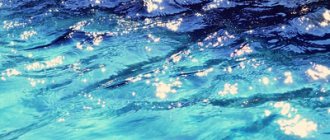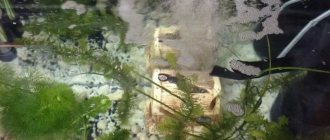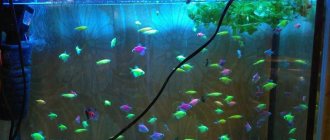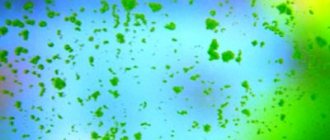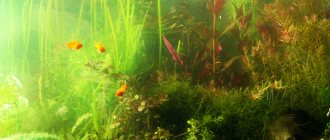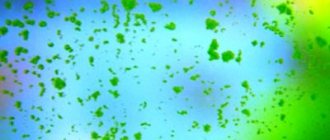Why does the water in the aquarium smell like a swamp?
With the help of an aquarium, your home will be filled with the beauty, comfort and warmth of exotic bodies of water. An aquarium is a great place to watch beautiful fish and relax in meditation. However, a damaged tank can ruin both your mood and the health of its inhabitants. Sometimes the water goes bad and smells like a swamp. Muddy water spoils the impression and makes the nursery unsuitable for further use. The problem requires an immediate solution, which involves identifying the cause and its immediate elimination.
Why do you need to settle water?
The main reason for this is harmful impurities that can harm the inhabitants of our aquarium. After settling, solid particles sometimes appear and precipitate. Initially clear water may become cloudy after some time.
Many aquarists leave the water for replacement to breathe for several days, and to ensure that all harmful suspensions have evaporated, for a week. This assumption is partially true, but it cannot guarantee the quality of the prepared water.
Before we do something, we always know why we need to do it. By keeping tap water out of the pipeline, we are trying to improve its characteristics so that it does not harm our fish. In other words, when water settles, we get rid of most of the harmful components.
Conditionally harmful substances found in water can be divided into:
- solid (sediment falls to the bottom);
- gaseous (evaporate from water into the environment);
- liquid (initially dissolved and remaining in water).
The settling process can only affect solid and gaseous mixtures, and it does not affect liquid substances in any way.
Caring for the plant environment
Photo from acuariorosa.files.com
Underwater flora has many benefits: they release oxygen necessary for fish, participate in maintaining biochemical balance, it is also a natural refuge and spawning place for aquarium inhabitants, and it is also a beautiful decorative element that enlivens the space. However, if the vegetation grows too abundantly, becomes covered with algae, blocks light from each other, interferes with the normal life of pets, and dies and rots, it causes harm and pollutes the water and everything in it.
In this case, you should weed out the algae, but be careful with the root species: you can raise bottom turbidity, which is very undesirable.
Necessary equipment
It is impossible to properly clean an aquarium without the use of special equipment. To clean the soil you will need aquarium cleaners: a siphon or a special aquarium vacuum cleaner. The choice of cleaner depends on how often the aquarium needs to be cleaned.
To clean the glass from plaque you will need a scraper. The simplest version of this tool is a plastic handle with a metal blade attached to the end. Magnetic scrapers can also be found in pet stores. They are used to clean tanks made of plexiglass and acrylic, because... they do not leave scratches on the material.
Other equipment that may be needed during the cleaning process:
- net;
- bucket or other deep container;
- sponge;
- brush;
- brush;
- rag;
- paper towels.
Cleaning the filter
An essential aspect in cleaning the filter is the elimination of exclusively mechanical impurities. The filter itself contains a whole colony of microorganisms important for the health of pets, which play a significant role in biofiltration. Porous fillers must be cleaned very carefully so as not to damage them or kill beneficial microflora. Also, do not wash the filter in waste water. It is better to use the cleanest and most unturbid aquarium water.
Filters with sponges, as well as those with separate containers for filler, etc., are cleaned once every 1–2 weeks. To understand that the filter is dirty, you need to look at the stream flowing out of it. If it seems weak or runs intermittently, the equipment needs cleaning.
How to quickly remove turbidity and lighten at home?
How to get rid of aquarium charcoal?
Important: you can only use special coal for an aquarium, which is sold in a pet store.
Charcoal purchased from a regular pharmacy is not suitable for cleaning the tank. How to clean an aquarium using charcoal?
- Be sure to rinse the charcoal before use.
- How much activated carbon should I put in? This primarily depends on the size of your aquarium. The recommendation is as follows: 5-20 grams per 50 liters of liquid.
- You need to hang the bag of charcoal close to the filter. You can use nylon fabric from stockings or tights for this.
- You need to change the coal at the moment when the water turns yellowish. Under normal conditions, this will happen in two to four months.
activated carbon is not a permanent remedy and must be used strictly in doses
Reducing or replacing feed
- Do not feed the fish for three to four days. Don’t be afraid: such unloading will only benefit them, but the bacteria will have nothing to feed on.
- If there is too much food, it settles at the bottom. Therefore, you need to either reduce the portions or replace the food with one that will be more popular among underwater inhabitants.
- If the size of the tank allows, then get bottom fish that will eat the remaining food accumulated at the bottom.
- Don’t forget about regular hygiene and cleaning the soil from fish food residues.
Checking the filter will help you achieve crystal clarity
The filter tends to get dirty periodically
- Remove the filter from the tank and disconnect the blocks with the filter element from each other.
- Disconnect the safety cap and disassemble it into two parts.
- Remove the filter motor.
- Rinse the filter element (usually a sponge) and all other parts of the device with running water.
- Use cotton swabs to clean the inside of the mechanical unit.
- Then remove any dirt from the air supply adapter. You can use a regular needle for this task.
- Let the parts dry and assemble them.
- Install the filter and run it. If this is the reason for the cloudy liquid, then you can consider that you have successfully dealt with the problem.
Cleaning or replacing soil
You can clean the soil using a special device - a siphon. Using a siphon, you need to stir the soil to its base so that the dirt particles go into the tube of this device. When the water at the tip of the device becomes clear, move on to the next section. This should be done approximately once a month.- If the soil is heavily polluted, it will have to be completely removed from the water by relocating the fish and replacing the water. Remove the soil from the bottom, rinse it thoroughly with running water without using additional detergents. Fill with water several times and then drain. After this, the soil can be returned to the aquarium.
How to replace the soil in an aquarium?
- Turn off all equipment in it.
- Drain ninety percent of the water into a clean bucket, canister, or covered tub.
- Remove all plants and decorations from the tank.
- Move the fish to another container.
- Drain off any remaining water.
- Remove old soil from the aquarium using a scoop.
- Thoroughly clean the aquarium of all contaminants and fill it with new soil.
- Install the decor and plants, fill with water.
- Release the fish.
- Start the equipment.
Reducing light intensity
- Connect the lighting to a timer so that the plants receive light in doses and do not have an excess of it.
- If your aquarium is new, do not turn on the lighting for more than six hours a day.
- Raise the lamp above the surface of the water. If this cannot be done, then close one of the lamps.
- Install lower wattage fluorescent lamps.
Resettlement of inhabitants
If there are too many fish in your aquarium, this may cause cloudiness
- Prepare a new aquarium into which you will move some of your pets.
- Equip it by creating the most similar conditions.
- Fill the aquarium with water; it is recommended to take some of the water from the old one to quickly establish biological balance in the new home.
- Relocate the fish.
Saturation of the reservoir with oxygen (aeration)
Aeration does not directly combat cloudiness of water, but is one of the prevention methods Enriching water with fresh oxygen
Special cleaning chemicals
You need to choose a special product based on the initial needs of your aquarium. Thus, some products are designed to combat cloudiness when the tank is first started, others are universal water optimizers in the aquarium.
- Tetra Aqua Bactozym . The drug is intended for bioactivation of the filter and water. Improves water quality and also promotes the proliferation of beneficial microorganisms. Perfect for use after changing water, since one of the distinctive properties of this product is the rapid restoration of biological balance. Makes cloudy water absolutely clear. The advantages of the drug include the enzymatic breakdown of feed residues and excrement, as well as the acceleration of the process of nitrate decomposition. The disadvantages include the rather high price. The cost of ten tablets in Moscow is from five hundred rubles, in St. Petersburg – from four hundred and fifty.
- Aquarium Pharmaceuticals Stress Coat Accu-Clear . Precipitator for cloudy water. Quickly cleans liquid from the smallest suspension and turbidity of various origins. Among the advantages of this product, it is worth noting its absolute safety for all aquarium inhabitants. Does not affect the chemical composition of water. The consumption is small: thirty milliliters of the drug is enough to purify more than a thousand liters of water. The downside is that this solution, despite all its positive characteristics, is difficult to obtain in Russia, so you will have to order from foreign online stores. Cost from three hundred rubles excluding delivery.
- Aquacons Clean Water . The product allows you to purify water to crystal clarity without changing its composition. The advantages include speed and low consumption. Negative aspects of use include the appearance of flakes, which are removed using a soil cleaner. The cost in Moscow is ninety rubles, in St. Petersburg you can buy it for seventy-five rubles.
Removing bad algae
To get rid of algae you need to:
- Use a siphon or your hands to remove these plants from the aquarium.
- Remove any remaining food on the ground and rotting plants.
- Change the filter media and increase water circulation.
- Every couple of days, change a quarter of the water in the container.
- Plant fast-growing plants, such as sagittaria, in the aquarium. You can also add a couple of floating ones - duckweed or paddling pool.
Chemical cleaning
In aquarium practice, chemical filtration is primarily understood as sorption. Depending on the type of sorption, various adsorbents are used - bodies capable of absorbing a substance with their (usually highly porous) surface, and chemical absorbers that bind a certain substance, entering into a chemical reaction with it.
A separate group is represented by ion exchange sorbents, passing through which the solution gives them ions of one type and takes away an equivalent amount of ions of another type.
zeolite
The most common chemical filtration is using activated carbon as an adsorbent. Some minerals belonging to the zeolite group, synthetic ion exchange resins and peat are used as chemical fillers. Ion exchange resins and zeolites absorb nitrates, ammonia, phosphates and some other substances, and instead release harmless ions of chlorine, sodium, and sulfates. Peat contains a rich set of amino acids and tannins. Therefore, its use as a filler slightly reduces the pH value, while simultaneously enriching the water with various biologically active substances, so necessary for the inhabitants of “black waters”.
Granulated peat
Sterilization of water can also be classified as chemical filtration. The main methods in aquarium practice are ultraviolet irradiation and ozonation.
Blue dolphin: keeping, compatibility, breeding, photo-video review
Blue dolphin Cyrtocara moorei, cyrtocara moorii
Order, family: cichlids (Cichlidae).
Comfortable water temperature for keeping Blue Dolphin:
24 - 28°C.
Ph: 7.2-8.5.
Aggression: moderately aggressive 50%.
Compatibility of the Blue Dolphin: small and medium cichlids, large barbs, catfish.
Personal experience and useful tips: Beautiful fish. For comfortable maintenance you need a large aquarium. Compatibility with other types of fish is limited, the fish of the cichlid family (Mbuna) no matter how. But, at the same time, this is perhaps the most modest species of cichlids; there is zero “Malawian spirit” in them. Today I got a couple of these beauties - they sit in the corner, shy away from sudden movements and sounds, and fall into a faint state from the siphon of the aquarium)))
Description:
In nature, it lives in the shallow sandy areas of Lake Malawi in Africa. Due to the strong similarity of the shape of the head and mouth with a mammal, it received its name. It was first brought to Europe in 1968.
The blue dolphin aquarium fish has a tall, slightly elongated body, flattened on the sides. Large head, large and mobile eyes, thick lips. An adult male has a large fatty growth on his forehead. The back and anal fins are long, the caudal fins are two-lobed. The ventral and pectoral fins are thin and short. Adults and juveniles can be distinguished by color. Juveniles are blue-gray with a silvery sheen and have dark transverse stripes on their sides. There is a large dark spot in the center of the body and on the caudal peduncle. Adults are velvety blue in color. The dominant male turns dark blue when excited. During spawning, its forehead turns yellow, and 5-7 dark blue transverse stripes appear on its side. All fins are colored blue. As a rule, the male is larger than the female. In nature, the blue dolphin can reach 25 cm. Life expectancy is up to 15 years.
The blue dolphin is a territorial, shy and peaceful fish. But, males periodically argue among themselves for leadership, without causing serious damage to each other. Dolphins are shy (even in proximity to African cichlids), so it is recommended to keep them in a species aquarium in the ratio of 1 male and 2 females or 2 males and 3 females. They stay in the middle and lower layers of water.
It is best to keep a blue dolphin in a spacious aquarium with a volume of 200-250 liters. with sandy soil, numerous shelters (cracks and grottoes made of stones) and free space for swimming. If you place plants in the aquarium, then you need to take only hard-leaved ones with a good root system or in pots. Water parameters for proper maintenance of blue dolphin: hardness 5 -20°, pH 7.2-8.5, temperature 24 - 28°C. Powerful filtration, aeration and weekly changes of up to 30-50% of the water volume are recommended. The blue dolphin reaches sexual maturity at the age of 12-18 months with a length of 13 cm. Reproduction and spawning are similar to most cichlids of Malawi and do not pose any special problems.
Feeding aquarium fish should be correct: balanced, varied. This fundamental rule is the key to the successful keeping of any fish, be it guppies or astronotuses. The article “How and how much to feed aquarium fish” talks about this in detail; it outlines the basic principles of the diet and feeding regime of the fish.
In this article, we note the most important thing - feeding fish should not be monotonous; the diet should include both dry food and live food. In addition, you need to take into account the gastronomic preferences of a particular fish and, depending on this, include in its diet food either with the highest protein content or, conversely, with plant ingredients.
Popular and popular food for fish, of course, is dry food. For example, you can constantly and everywhere find food on aquarium shelves - the leader of the Russian market; in fact, the range of food for this Tetra is included as individual food for a specific type of fish: for goldfish, for cichlids, for loricariids, guppies, labyrinths, arowanas, discus, etc. .d. Tetra has also developed specialized foods, for example, to enhance color, fortified, or for feeding fry. You can find out detailed information about all Tetra feeds on the company’s official website - here .
It should be noted that when purchasing any dry food, you should pay attention to the date of its manufacture and shelf life, try not to buy food in bulk, and also store the food in a closed state - this will help to avoid the development of pathogenic flora in it.
Beautiful photo with blue dolphins
Interesting video with blue dolphins
fanfishka.ru>
How to keep it clean?
To maintain the crystal purity of water in the aquarium, in addition to the measures described above, experienced aquarists recommend the following measures:
- Cover the aquarium with a lid of a suitable size to prevent dust and dirt from getting inside. But at the same time, for normal air exchange it is necessary to leave a small gap.
- Constantly monitor “population density.”
- Rationize food. It is easy to determine the required portion for a “one meal” experimentally and stick to it in the future.
- Regularly inspect the aquarium, monitor the state of the ecosystem, and immediately get rid of dead algae and dead fauna. You should also not allow any objects or substances that are not intended for the aquarium to get into the water.
- Everything that is planned to be placed in the aquarium (soil, decorative elements, new algae) should be thoroughly washed beforehand, and if this is permissible, also disinfected (for example, in boiling water).
- Monitor the temperature and the length of daylight hours.
- Plant algae that are easy to maintain, not prone to active growth and capable of purifying water - for example, hygrophila, vallisneria, ambulia.
Important!
Sand is not the most suitable soil for an aquarium. It is this that often produces sediment, which causes cloudiness in the water. It is strongly not recommended to fertilize the substrate at the bottom unless absolutely necessary.
How to prepare water?
The right aquarium is not one where fish frolic and plants sway, but one where suitable conditions are created for the long life of pets. First of all, the well-being of fish is influenced by the aquatic environment, so the water in the aquarium should be free of potentially dangerous impurities and substances. To prepare a liquid for a tank means to eliminate metals, impurities, chlorine, nitrogen and phosphates from the composition. This can be done at home.
For preparation, you will need a wide, capacious vessel, for example, a large basin or bucket. It is not recommended to use containers that once contained chemicals or detergents. Then they begin to remove harmful substances and impurities using one of the following methods:
- Conditioners sold in pet stores.
- Sodium thiosulfate – helps eliminate the bond between chlorine and ammonia. Dosage – 10 g/100 l. The product is first diluted in a glass, and after adding it to the tank, aeration is turned on for 2-3 hours.
- Osmotic or deionization filters. To remove some of the impurities, you can add distilled water.
Cleaning decorative elements
If the house or other parts of the underwater interior become coated or cloudy, the dirt can be easily removed with a brush. This can be done in an aquarium or in another container filled with aquarium liquid (this is important in order not to introduce a foreign infection and preserve beneficial microflora). Do not use household cleaning products; they are not necessary, and the chemical composition of the products can have a detrimental effect on underwater inhabitants. By remembering these simple rules, you will not only understand how to care for your home aquarium, but will also make your life much easier.
There are fish that eat algae. They will not be able to solve the problem of cleaning the aquarium from contamination, but cleaning will become less frequent.
Please advise how to achieve clear water in an aquarium. There is a filter, but it only disturbs the water?
Stich
It’s not already, but STILL muddy. Do not touch the water; microflora is established in it and cloudiness is a consequence of the active proliferation of bacteria, which are necessary for the normal existence of fish and plants. After some time, the water will become transparent and acquire the “correct” yellowish tint.
Vika
Remove the aquarium from the sun so that direct rays do not fall on it. A special liquid for water in the aquarium is sold 10 grams per 50 liters, add once. Do not add a lot of food, only in the morning and evening. Buy special fish for cleaning sand, catfish ( for 50 liters 3 pieces), and fish that clean the walls of the aquarium. Wash the filter once a week (if it is not of very good quality)
User deleted
Luda, first of all, you shouldn’t put it in there right away, because everything in the aquarium needs to settle down. Plant plants, put all sorts of pebbles there, etc. When the so-called biological balance is established, that is, the water becomes clear, introduce the fish. There are, of course, various baubles for aquatics, such as ANTI_BLUE_GREEN ALGAE, but you don’t really need them right now. Place the fish in a jar with a compressor and leave the aquarium alone for a while. Don't forget to put snails there! Good luck!
AndreyLed
Maybe the soil is poorly cleaned, the algae is not washed out. The filter may be defective. The aquarium should not be in the sun. Feed the fish only in the morning and evening. The amount of feed is minimal. Catfish and snails collect fallen food from the bottom.
Lenush
The filter may not be suitable for your aquarium. It is very important to clean it on time... or the water pressure is simply too strong. There are also snails, but there is a problem with them, they multiply very quickly. Small ones can get into the filter...
Pollution prevention
In order to avoid rapid contamination of the aquarium and frequent forced cleanings, it is necessary to carry out preventive measures, which include the following:
- Avoid direct exposure to sunlight. To do this, the tank must initially be positioned correctly. Under no circumstances should you install it directly under the window (there should be at least 1 m of indentation).
- Give preference to artificial lighting using special lamps on the lid.
- Correctly pour the bottom filler - it is better to place it near the front wall, this will facilitate the process of regular cleaning.
- Do not overfeed the fish. An excess of feed leads to rapid turbidity of the water. Portions of food should be such that the inhabitants of the artificial reservoir eat them in no more than five minutes.
- Trim aquatic plants in a timely manner and remove dead and fallen leaves.
- Make sure that natural cleaners live in the aquarium - swordtail, guppies, platies, Ancistrus catfish, snails. These individuals have a mouth designed in such a way that it resembles a natural scraper, and their food is lower aquatic plants, even blackbeard and Vietnamese.
